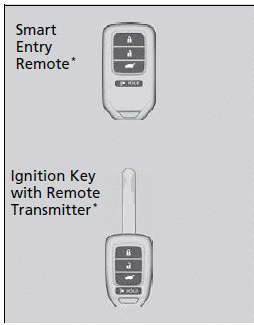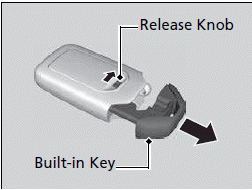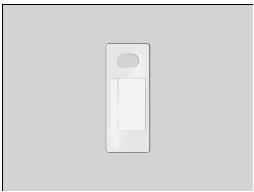Honda HR-V: Key Types and Functions
All the keys have an immobilizer system. The immobilizer system helps to protect against vehicle theft.
The keys contain precision electronics.
Adhere to the following advice to prevent damage to the electronics:
- Do not leave the keys in direct sunlight, or in locations with high temperature or high humidity.
- Do not drop the keys or set heavy objects on them.
- Keep the keys away from liquids.
- Do not take the keys apart except for replacing the battery.
If the circuits in the keys are damaged, the engine may not start, and the remote transmitter/smart entry system* may not work.
If the keys do not work properly, have them inspected by a dealer.
This vehicle comes with the following keys:
â– Keys
Models with smart entry system
Use the smart entry remote to start and stop the engine, and to lock and unlock all the doors and tailgate. You can also use the smart entry system to lock and unlock the doors and tailgate.
Models without smart entry system
Use the key to start and stop the engine, and to lock and unlock all the doors and tailgate.
You can also use the remote transmitter to lock and unlock the doors and tailgate.

â– Smart entry remote
The built-in key can be used to lock/unlock the doors when the smart entry remote battery becomes weak and the power door lock/ unlock operation is disabled.
To remove the built-in key, pull it out while sliding the release knob. To reinstall the built-in key, push the built-in key into the smart entry remote until it clicks.

â– Key Number Tag
Contains a number that you will need if you purchase a replacement key.

Keep the key number tag separate from the key in a safe place outside of a vehicle.
If you wish to purchase an additional key, contact a dealer.
If you lose your key and you cannot start the engine, contact a dealer.
Low Smart Entry Remote Signal Strength
The vehicle transmits radio waves to locate the smart entry remote when locking/ unlocking the doors and tailgate, or to start the engine.
In the following cases, locking/unlocking the doors and tailgate, or starting the engine may be inhibited or operation may be unstable:
- Strong radio waves are being transmitted by nearby equipment.
- You are carrying the smart entry remote together with telecommunications equipment, laptop computers, cell phones, or wireless devices.
- A metallic object is touching or covering the smart entry remote.
Communication between the smart entry remote and the vehicle consumes the smart entry remote's battery.
Battery life is about two years, but this varies depending on regularity of use.
The battery is consumed whenever the smart entry remote is receiving strong radio waves. Avoid placing it near electrical appliances such as televisions and personal computers.

